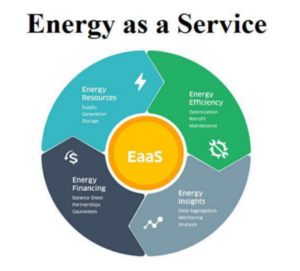Energy as a Service
Energy as a Service is a delivery model that combines hardware, software and services into a scalable enterprise platform. These energy solutions should combine demand management and energy efficiency services, facilitate the adoption of renewables and other decentralized supply sources, and also optimize the balance between demand and supply.
The chief benefit for the consumer is in the simplification of an increasingly multifaceted service offering. The physical, digital and communications infrastructure required means that a range of players can participate in the EaaS market.

The chief benefit for the consumer is in the simplification of an increasingly multifaceted service offering. The physical, digital and communications infrastructure required means that a range of players can participate in the EaaS market.
Appling enterprise to scale solutions work to interconnect such smart asset areas of utilities, industrial companies, tech companies. The result produces a large array of data-driven energy products and services that incorporate new technologies and efficiency improvements.
Multiple entities, from corporations to cities, are making moves to prepare for this future. There are likely to be more changes in the next ten years than there have been in the previous 100 years, as the Grid becomes Smarter.
These trending developments will play out at national, regional and local levels in profound ways unimagined in just the last 10 years alone. Some of these obvious changes will incorporate the following touch tones in terms of Distributed Energy benefits.
- Deployment of low cost distributed generation and microgeneration
- Adoption of connected technologies and intelligent technologies
- Expansion of energy efficiency and behind the meter benefits
- Installation of utility-scale storage and enhanced balance of system
- Embracing new market participants and at scale collaboration
- Harnessing big data and visibility and better end energy demand and response
- Development of local energy markets and more clean energy options.
Energy as a Service solution will become increasingly important across multiple markets, especially in Smart City type delivery scenarios where these market forces are currently at play.
Energy as a Service Platform
Provides the end infrastructure crucial solution; Whereby, the fallen giant or the stagnant utility company has little options to reinvent themselves, and ultimately they face the notion of how might they improve or reinvent themselves as in order to deliver on new ways to promote and provide a wider range of affordable energy options to the ultimate public or private end customer.
As a result business models will need to transform, in some cases significantly, in order to keep pace in the new normal.
The same trends that have disrupted retail, transport and consumer electronics are coming to the energy markets. Companies should identify the opportunities they can exploit, the capabilities they will need to do this, and what market segments have the greatest potential to drive their
future growth.
They can sequence the shift to Energy as a Service offerings in the following stages:
- Digitize core capabilities and expand product and service range to create 360 solutions. Gone will be the traditional model of centralized generation, where energy flows in one direction to passive, rate-paying consumers.
- Everyone will be able to generate as well as consume. Imagine a highly synchronized and sustainable energy platform, where millions of smart physical assets interconnect. A digital layer coordinates and distributes both energy and information in real-time, enabling myriad interactive products and services to be traded.
- The result will be a large array of data-driven energy products and services that incorporate efficiency improvements and new technologies. People will be able to manage their excess supply through peer-to-peer (P2P) markets. Energy will be bundled into customer-centric subscription models and sold as a secondary product embedded in primary products, such as ‘an electric car that has power’ or ‘a home that is warm.
- The evolving energy landscape will become vastly more complex as the cost to produce comes down, the ability to generate moves to micro levels, and products are serviced on digital platforms. End-users will look for an aggregating agent to act as a single source point for all their energy-related needs.
- This will create opportunities for providers who can deliver a streamlined, cost- effective solution to clients, all for a fixed monthly payment. A lot has to happen to make this a widespread reality, but multiple entities from corporations to cities are gearing up for such
a future.